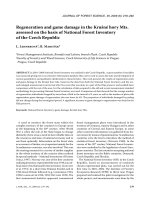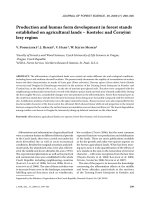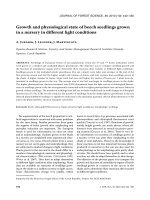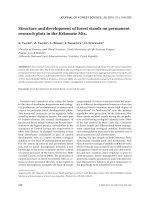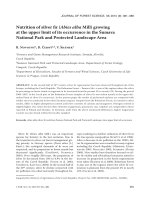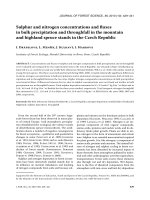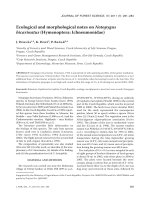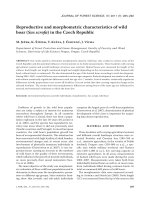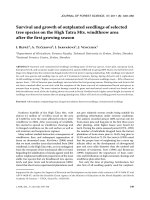Báo cáo lâm nghiệp: "rowth and health state of silver fir (Abies alba Mill.) in the ridge area of the Jizerské hory Mts" docx
Bạn đang xem bản rút gọn của tài liệu. Xem và tải ngay bản đầy đủ của tài liệu tại đây (315.62 KB, 10 trang )
J. FOR. SCI., 54, 2008 (11): 509–518 509
JOURNAL OF FOREST SCIENCE, 54, 2008 (11): 509–518
e silver fir (Abies alba Mill.) belongs to the most
important tree species in the forests of the Czech
Republic, its original representation in the area of
the Jizerské hory Mts. having been ca 19% (V
et al. 2003). Its natural occurrence in the Jizerské
hory Mts. ranges from the beech with oak Forest
Altitudinal Zone (FAZ) to the spruce FAZ, i.e. up to
the altitude of about 1,000 m above sea level, while
the optimum of occurrence lies in the beech with fir
FAZ at an altitude from 480 to 590 m a.s.l. Besides
an economic effect, the fir also fulfils ecological
functions and therefore it belongs to the ameliora-
tive and stabilising tree species (OPRL 1999). For its
importance, the silver fir was included in a plant-
ing experiment situated on the ridge, because it is
considered as a suitable species for mid to higher
altitudes (sufficient amount of precipitation) under
the conditions of a decreased sulphur dioxide load
(E et al. 2003). erefore, the fir plots
were established to test its prosperity and use in new
forest stands in localities formerly afflicted by a high
pollution load in the period from the mid-seventies
to the mid-nineties of the last century.
MATERIAL AND METHODS
Research plot (RP) was established on a clearing
due to salvage felling (an area of about 20 ha) in the
upper part of the south-western slope as a locality
representing very adverse growth conditions of the
summit area of the mountains. e locality is situ-
ated at an altitude of 950 to 980 m, 50°49'34''NL and
15°21'19''EL. According to Forest Management In-
stitute (ÚHÚL) classification, the site of RP belongs
to acidic spruce forest (FAZ 8 K, OPRL 1999) which
is considered as a typical site in the summit parts of
the Jizerské hory Mts., though the investigation of
the climate (1994–2007, see Results and Discussion)
reveals milder conditions being expected in lower
sites (acidic spruce with beech stands, FAZ 7 K,
OPRL 1999). Soil type is Ferro-Humic Podzol (FAO),
the parent rock is biotitic granite.
Supported by the Ministry of Agriculture of the Czech Republic, Project No. MZe 0002070201.
Growth and health state of silver fir (Abies alba Mill.)
in the ridge area of the Jizerské hory Mts.
V. B, D. K
Forestry and Game Management Research Institute, Strnady, Opočno Research Station,
Opočno, Czech Republic
ABSTRACT: e silver fir was planted under mountain conditions in order to reveal its response to the addition of
finely ground rocks (limestone and amphibolite) mixed with soil into the planting holes. e results document that
the increments of the plantations fertilised with amphibolite were higher by 25% on average than those of the control
plantations while the increments of the plantations treated with dolomitic limestone were lower by 13%. Generally, as
concerns both the plantations with the application of ground rocks and the control ones, the development of the fir
plantations in 1994–2007 is considered successful. As the damage by climatic stresses has gradually diminished, the
number of dead trees has been decreasing and the height increments have been increasing in the last years, therefore
a positive development is to be expected also in future.
Keywords: silver fir; Abies alba Mill.; artificial regeneration; chemical amelioration
510 J. FOR. SCI., 54, 2008 (11): 509–518
Five-year old, bare-rooted plants of the silver fir were
planted within the research plot in the spring of 1994,
at a spacing of 2 × 1 m onto square parcels 10 × 10 m in
size (i.e. 50 individuals per parcel). e average initial
height of the fir plantations was 18 cm. To minimise
the influence of random differences on the growth con-
ditions (soil conditions, microrelief, etc.), the plantings
on the research plot were distributed into three blocks
– replications, each replication included all variants;
i.e. 450 fir plantings were planted altogether (control +
ameliorated). e tests of the potential support to the
vitality of the fir plantations by means of ameliorating
measures were a part of the experiment. A part of the
plantings was standard without soil amelioration treat-
ment (control), in another part finely ground dolomitic
limestone and finely ground amphibolite were added
into the soil (B et al. 2005).
(Note: Dolomitic limestone of Horní Lánov origin
contained 21.5% Ca and 11.3% Mg and consisted
of these particle-size fractions: 57.5% of particles
smaller than 0.2 mm, 20.4% of particles 0.2–0.5 mm
in diameter, 16.3% of particles 0.5–1.0 mm in dia-
meter, and 5.8% particles larger than 1.0 mm. Am-
phibolite of Markovice origin contained 7.9% Ca,
4.8% Mg, 0.8% K, and 0.1% P, and its particle-size
structure was as follows: 42% of particles smaller
than 0.05 mm, 53% of particles 0.50–0.25 mm in
diameter, and 5% of particles larger than 0.25 mm.)
Both these ground rocks were mixed with soil in
the hole during planting, dolomitic limestone and
amphibolite were applied in the amounts of 1 kg and
2 kg per plant, respectively (B, P
1995; P, B 1996; K et al. 2004).
e amount of limestone was chosen based on pre-
vious positive experience with such ameliorative
material added to support the growth of plantings
near Trutnov (T 1968), in the Orlické hory Mts.
and Jizerské hory Mts. (P 1994). e dose
of amphibolite was higher since the nutrient release
and subsequent influence upon soil acidity were ex-
pected to be delayed compared to limestone.
Health state of plantings – the occurrence of
the damage symptoms and mortality – was checked
every year in spring. If the frequency of the dam-
age symptoms was higher (damage to foliage due to
ground frost, etc.), the spring check was repeated,
and the proportion of damaged needles was estimat-
ed. e second check of the health state combined
with the measuring of the heights of all tested trees
was carried out after the growth termination at the
beginning of autumn. e height growth was evalu-
ated according to the parameters of all living fir indi-
viduals in 2007 and according to 20% of the highest
individuals to avoid an undesirable distortion of the
Table 1. Average monthly air temperatures from July 1997 to June 2007 registered by the NOEL 2000 station on Jizerka research plot (°C)
I II III IV V VI VII VIII IX X XI XII I–XII V–X
1996 12.0 14.0 5.9 6.1 0.9 –7.0
1997 –4.0 –2.0 0.1 0.7 9.1 13.0 13.0 16.0 10.0 2.3 0.0 –2.0 4.7 10.6
1998 –2.0 0.0 –2.0 5.7 9.8 13.0 13.0 13.0 9.3 4.0 –3.0 –4.0 4.7 10.4
1999 –3.0 –5.0 0.8 4.8 9.8 11.0 15.0 14.0 14.0 4.7 –1.0 –4.0 5.1 11.4
2000 –5.0 –2.0 –0.7 7.5 12.0 13.7 11.3 15.4 10.0 8.4 3.0 –1.0 6.1 11.8
2001 –3.6 –2.4 –0.7 3.2 11.1 10.6 15.0 15.6 8.0 9.3 –1.1 –5.2 5.0 11.6
2002 –2.3 0.2 1.1 4.1 12.8 13.4 14.9 16.4 9.1 3.1 1.5 –5.2 5.8 11.6
2003 –5.4 –5.2 0.4 3.2 11.4 15.3 14.6 16.5 10.6 1.1 2.9 –2.7 5.2 11.6
2004 –6.7 –3.3
–0.8 5.1 7.1 11.3 13.3 14.8 9.7 6.3 0.0 –2.7 4.5 10.4
2005 –3.7 –5.7 –2.7 5.5 9.6 12.2 14.7 12.7 12.0 7.3 –0.7 –3.9 4.8 11.4
2006 –5.2 –6.3 –3.6 4.5 9.2 14.1 19.6 12.0 13.4 8.0 2.7 0.0 5.7 12.7
2007 –1.2 –1.3 2.2 7.7 11.3 14.1 13.6 13.8 7.5
Average –3.8 –3.0 –0.5 4.7 10.3 12.9 14.2 14.5 10.0 5.5 0.5 –3.4 5.1 11.2
e values of IV and V 1997 were calculated by interpolation according to the nearest station of Czech Hydrometeorological Institute (CHMI) – Souš
J. FOR. SCI., 54, 2008 (11): 509–518 511
results – average values – by differences in mortality
between the planting variants and by the survival of
declining individuals with the growth stagnation.
Nutrient state of the tested plantings was indicated
by the results of chemical analyses of needles. Mixed
samples of needles were taken from the upper parts
of the crown in 10 trees on each parcel (replication),
i.e. from 30 individuals. e analyses were done in
Tomáš Laboratory in Opočno Research Station in
accordance with the standardised methods (Z
1994). e plots were fenced to protect the planta-
tions against the game (deer and hare) browsing.
As for the climate conditions, precipitation is
measured with a conventional rain gauge all over
the year, and the snow cover thickness is measured
in weekly exposure periods. Since 1996, air tem-
peratures at a height of 200 cm and 30 cm above the
ground have been registered and soil temperatures
at a depth of 20 cm in one-hour intervals have been
recorded using a NOEL 2000 automated station lo-
cated directly on the research plot. e station also
records the rainfall in one-hour intervals and soil
moisture content in daily intervals.
e differences between the biometric parameters
in the planting variants and blocks were tested using
t-test, confidence intervals, and two-factor analysis
of variance ANOVA (M, M 2002).
RESULTS AND DISCUSSION
Average annual temperatures at a height of 200 cm
above the ground in the period of measurement (July
1996–October 2007) ranged from 4.5°C to 6.1°C, the
average being 5.1°C. Temperatures in one-hour in-
tervals ranged from –21.6°C to 31.6°C. In the grow-
ing season (May to October), the average of monthly
temperatures was 11.2°C (Tables 1 and 2).
e fluctuations of surface temperatures (+30 cm
above the ground) in the dormant season (Novem-
ber–April) were diminished by the snow cover every
year (Fig. 1). In the growing season (May–October),
the average surface temperature (11.6°C) was higher
by 3 tenths of a degree than the above-mentioned
temperature at two metres above the ground, but
the range of the means of extreme temperatures was
substantially wider (the mean of maximum tem-
peratures 32.5°C and that of minimum temperatures
–4.6°C).
Annual precipitation amounts measured on
Jizerka RP in the period of January 1994–September
2007 fluctuated in the range from 690 to 1,373 mm,
and their average annual amount was 1,093 mm
(Table 3). e rainfalls were the highest from June
to September – with the month average of 130 mm,
while the highest month rainfall amounts were re-
corded in July 1997 (527 mm) and in August 2006
(522 mm).
Based on continuous observations of the climate
elements until September 2007, a conclusion was
drawn about great differences from the expected
parameters. The average annual air temperature
(5.2°C) was markedly higher than the temperature
anticipated for the given locality (4.0°C) with respect
to the location in the Spruce Altitudinal Zone (OPRL
Table 2. Average monthly air temperatures and temperature extremes from July 1997 to June 2007 registered by the
NOEL 2000 station on Jizerka research plot (°C)
Month
+200 cm above the ground +30 cm above the ground
mean maximum minimum mean maximum minimum
January –3.8 11.4 –21.6 –1.8 12.2 –19.6
February –3.0 12.7 –19.5 –0.8 12.4 –13.7
March –0.5 16.4 –16.8 –0.1 16.5 –14.5
April 4.7 22.6 –10.6 4.6 26.4 –11.2
May 10.3 28.0 –2.5 10.8 31.2 –6.9
June 12.9 30.2 –0.1 13.4 34.8 –2.6
July 14.2 31.6 3.8 14.7 36.1 0.7
August 14.6 31.1 3.8 14.7 36.8 –1.0
September 10.2 24.6 –1.1 10.3 30.0 –5.4
October 5.5 22.0 –9.1 5.5 26.1 –12.6
November 0.5 15.0 –15.7 0.7 17.8 –13.2
December –3.4 12.6 –19.6 –2.4 14.7 –18.5
Mean I–XII 5.2 21.5 –9.1 5.8 24.6 –9.9
Mean V–X 11.2 27.9 –0.9 11.6 32.5 –4.6
512 J. FOR. SCI., 54, 2008 (11): 509–518
1999; V et al. 2003) as well as with respect to
the data from previous measurements of Czech
Hydrometeorological Institute (CHMI) (S
et al. 2005). On the contrary, the average annual
precipitation amount (1,093 mm) was lower than
that anticipated (1,450 mm).
As expected, the tested plantations of the silver
fir were damaged due to late ground frosts already
in the first years after planting. In the research plot
locality, flushing took place according to the air tem-
perature in the given period usually from the end of
May to the end of June, and new shoots were often
damaged mainly by June frost episodes. Besides the
flushing stage, the extent of damage expressed by the
number of the damaged individuals was influenced
by the value of air temperature drop in the ground
layer and by the duration of frost episodes (Table 4).
Especially in the first years after planting, repeated
damage to newly flushed shoots slowed down the
growth and led to the mortality of afflicted individu-
als. e damage by ground frost occurred only in
the surface layer up to a height of 60–100 cm above
the ground. e shoots above this height were not
damaged, and therefore the ground frosts in the last
years, when the majority of the shoots exceeded this
height, did not significantly influence the overall vi-
tality of the plantations any longer (Figs. 2 and 3).
Besides late frosts, the plantations of the silver fir
suffered from desiccation of older year needles in
early spring due to insolation and increased tem-
perature of the air surface layer at low temperatures
of soil mostly covered by snow. But the development
of the plantations was not influenced by this type of
damage very much. e high snow covers caused
the top breakage and stem deformations in the fir
plantations in the last two years. e numbers of the
damaged individuals were relatively low – 1% of trees
were damaged in 2005 and 2% in 2006, respectively,
0
50
100
150
200
250
15/10/96
25/12/97
17/12/98
4/12/99
16/11/00
28/10/01
11/10/02
26/9/03
25/9/04
9/9/05
27/08/06
(cm)
Fig. 1. Average snow cover thickness
measured in weekly intervals on Jizerka
RP from October 1996 to May 2007
Table 3. Average monthly precipitation amounts measured by the standard method on Jizerka research plot (mm)
Year I II III IV V VI VII VIII IX X XI XII Year
1994 36 18 71 62 84 76 66 141 68 111 71 74 878
1995 257 63 164 95 89 104 78 131 114 10 49 20 1,174
1996 3 33 109 122 142 152 205 86 155 95 92 17 1,210
1997 6 60 43 73 154 82 527 75 35 152 26 63 1,296
1998 45 34 54 42 37 144 155 92 201 166 113 48 1,131
1999 42 61 40 32 63 121 138 40 66 150 28 47 828
2000 67 108 122 4 101 41 245 36 99 48 64 39 975
2001 49 55 57 72 59 156 213 66 277 50 101 69 1,224
2002 42 56 26 52 101 67 135 242 121 148 76 44 1,110
2003 102 26 31 44 40 25 100 30 66 135 20 71 690
2004 103 47 48 53 92 103 131 132 105 60 131 66 1,071
2005 88 82 70 21 101 178 134 169 116 23 54 131 1,166
2006 41 77 60 40 71 109 20 522 53 85 226 68 1,373
2007 144 101 63 3 107 100 145 86 187
Mean 73 59 68 51 89 104 164 132 119 95 81 58 1,093
15. 10. 1996
5. 6. 1998
22. 10. 1999
9. 3. 2001
18. 7. 2002
11. 12. 2003
6. 5. 2005
23. 9. 2006
J. FOR. SCI., 54, 2008 (11): 509–518 513
which was insignificant for the development of the
tested plantations.
e mortality of the silver fir experimental planta-
tions on Jizerka research plot was lower than expected,
in spite of the fact, that the plantings were situated on
the margin of the tree species ecological amplitude
(spruce altitudinal zone). About a quarter (28%) of the
planted trees died in the first six years after planting,
in the next seven years it was less than a tenth (9%,
Table 5). Total mortality of the silver fir experimental
plantations was 37% on average. e mortality of the
control plantings was higher ca by 10% than that of
the plantings treated with dolomitic limestone and
amphibolite. But these differences also correspond to
the differences between the planting replications, and
so they are not considered as particularly important.
e dynamics of the height growth of the silver fir
experimental plantings was evaluated on the basis
of the results of the measurements of all trees liv-
ing in 2007, and of the highest trees in 2007 (= 20%
of the plants, i.e. the 10 highest trees per parcel, in
total 30 individuals per planting variant). e results
document a marked transplanting shock in the first
six years (1994–1999) that slowed down the growth
of these trees. e differences between the planting
variants were relatively small and statistically insig-
nificant at that time. Later on, there was a gradual
increase in the height increments that were higher
in the variant fertilised with amphibolite than in the
control and limed variants in the period 2000–2004.
e differences were statistically significant in cer-
tain years only. In the last three years (2005–2007),
such a trend was not observed any more. e growth
was the slowest in the variant with dolomitic lime-
stone application, the increments having been on
average lower by 11% than in the control variant,
Fig. 2. Newly flushed shoots of silver fir damaged by late
ground frost on Jizerka research plot in June 2005
Fig. 3. Detailed view of newly flushed shoots of silver fir damaged
by late ground frost on Jizerka research plot in June 2005
Table 4. June minimum temperatures, late ground frosts, and the percentage of damaged individuals of silver fir on
Jizerka RP
Year
Date of minimum
temperature
Min. temperature at
30 cm above ground (°C)
Frost duration
(h)
Damaged individuals
(%)
1998 June 18
th
0.7 0 0
1999 June 24
th
–0.3 1 0
2000 June 1
st
–0.8 5 87
2001 June 13
th
–1.6 1 57
2002 June 1
st
1.6 0 0
2003 June 14
th
1.9 0 0
2004 June 27
th
1.4 0 0
2005 June 2
nd
–1.9 8 100
2006 June 2
nd
–2.6 9 100
2007 June 1
st
1.8 0 0
514 J. FOR. SCI., 54, 2008 (11): 509–518
and lower by 23% than in the variant fertilised with
amphibolite (6). Certain (expected) heterogeneity of
the growth conditions in the locality of the research
plot is documented by the differences in the growth
of the tested plantings in replications in three blocks
that amounted to 19% on average. e differences
Table 5. Mortality of silver fir plantations 1994–2007 (%)
Period Control Limestone Amphibolite Mean
1994 2.1 8.8 6.0 5.6
1995 13.1 5.4 6.7 8.4
1996 4.8 2.7 2.0 3.2
1997 1.4 1.4 2.0 1.6
1998 9.7 4.1 5.4 6.4
1999 2.8 2.0 2.7 2.5
2000 0.0 1.4 1.3 0.9
2001 1.4 1.4 3.4 2.0
2002 3.4 2.7 0.0 2.1
2003 0.0 0.0 0.7 0.2
2004 0.0 0.7 0.0 0.2
2005 0.7 2.0 1.3 1.4
2006 0.0 0.0 0.7 0.2
2007 0.7 0.0 0.7 0.5
1994–2000 33.8 25.7 26.2 28.5
2001–2007 6.2 6.8 6.7 6.6
1994–2007 40.0 32.4 32.9 35.1
Table 6. Basal height (h 1993) and height increments (ih 1994 …) of all trees alive in 2007 and the highest 20% trees of
silver fir plantations (cm)
All trees alive in 2007 Highest 20% trees
C L A
mean C L A mean
h 1993 19.5a 18.5a 19.2a 19.1 25.3a 26.3a 26.4a 26.0
ih 1994 1.4a 1.7a 1.6a 1.5 1.8a 1.9a 1.8a 1.8
ih 1995 1.6a 3.2b 3.3b 2.7 1.5a 4.5b 3.6ab 3.2
ih 1996 4.0a 5.5b 6.6c 5.3 5.5a 7.3ab 7.6b 6.8
ih 1997 3.1a 3.1ab 3.8b 3.3 4.6a 4.8a 4.3a 4.6
ih 1998 4.2ab 3.9a 5.1b 4.4 5.4a 6.4a 6.7a 6.2
ih 1999 2.9a 2.7a 3.5a 3.0 3.8a 5.1a 5.2a 4.7
ih 2000 4.6b 2.3a 3.6a 3.5 7.7a 5.1a 7.1a 6.6
ih 2001 6.4ab 5.5a 7.9b 6.6 10.6a 9.9a 13.9a 11.5
ih 2002 9.2a 8.6a 14.1b 10.6 15.6a 16.5a 20.8a 17.6
ih 2003 10.5a 8.6a 14.4b 11.1 17.1a 14.9a 20.2a 17.4
ih 2004 9.6b 6.9a 12.5b 9.7 15.5a 15.2a 21.4a 17.4
ih 2005 7.3ab 4.9a 7.3b 6.5 11.7a 11.4a 13.2a 12.1
ih 2006 11.3ab 8.5a 12.1b 10.6 21.9a 17.7a 20.8a 20.1
ih 2007 14.6ab 11.5a 17.1b 14.4 26.4a 24.9a 28.7a 26.7
ih 1994–2000 21.8a 22.3a 27.3b 23.8 30.2a 35.1a 36.2a 33.9
ih 2001–2007 68.8b 54.7a 85.2c 69.6 118.8ab 110.5a 138.9b 122.7
ih 1994–2007 90.6b 76.9a 112.6c 93.4 149.0a 145.6a 175.1a 156.6
Plantation variants: C – control, L – limed, A – with amphibolite, statistically homogeneous groups (a, b, c) according to
results of Kruskal-Wallis test (probability 95%)
J. FOR. SCI., 54, 2008 (11): 509–518 515
between the height increments of the planting vari-
ants (control, amphibolite, limestone) and the incre-
ments in replications in 1994–1999 and 2000–2006
were confirmed by the computations of statistical
confidences.
Based on the results of two-factor analysis of
variance ANOVA for the height increments in
1994–2004, it is possible to state with the 20% of the
highest trees that the different growth conditions
tested by three planting replications contributed
to the variance of the resultant values during the
experiment (1994–2007) to a larger extent than the
variants with different applications of ameliorative
treatment (control, limestone, amphibolite).
e dynamics of the height growth of all indi-
viduals that were alive in 2007 on the research
plot has a similar trend as the selected 20% of the
highest trees (Table 6). In the sets of all trees that
were alive in 2007, at the beginning of the experi-
ment the height increments of the fir plantations
after the application of amphibolite and dolomitic
limestone were higher than in the control variant.
Later on, the limestone-treated plantations slowed
down their growth, and at present (2007) the total
increments are lower by 13% on average than those
in the control plantations. e amphibolite-treated
plantations had a higher vitality also in the second
half of the experiment (2000–2006) and their av-
erage increment is higher by 25% than that in the
control plantation.
If compared with analogical experimental planta-
tions, our results are comparable with the silver fir
development in Lesní bouda locality in the Krkonoše
Mts. (altitude 1,080 m a.s.l., K 2002), where
the average six-year height increment was 22 cm.
Contrary to the previous statement concerning the
unsuitability of the fir in summit parts of the Czech
mountains (Z 2001), the fir planted under
the conditions of spruce with beech-spruce FAZ
grew successfully in juvenile stage. e growth ca-
pacity of plantations in the mountain and foothills
localities at lower altitudes with more favourable
growth conditions was higher, e.g. in Fláje local-
ity at an altitude of 800 m a.s.l. (Krušné hory Mts.
– K, B 2004) or in Lanovka locality at
the altitude of 520 m (Broumovská vrchovina upland
– B 1991).
On the Polish side of the Jizerské hory Mts., the
performance of the silver fir plantations had been
tested by N and G (1999). On the ex-
perimental plot established in 1992 at the elevation
of 950 m a.s.l., five-year mortality of the fir plantation
was 26% and its average height was about 32 cm,
thus their development was very similar to our con-
trol variant (five-year mortality 31%, height 32 cm,
see Tables 5 and 6). A later experiment concerning
the fir planted in the Polish Jizerské hory Mts. was
published by H et al. (2004). Mean mortal-
ity of all planted firs (6 provenances) on the higher
situated experimental series (960 m a.s.l.) exceeded
Table 7. Contents of main nutrients in one-year needles of silver fir and limits of optimum nutrition according to
B (1988)
Element
Variant 1996 2001 2002 2003 2004 2005 2006 Mean
Optimum
limits
N (%) control 1.423 1.327 1.131 1.025 1.085 1.492 1.146 1.233
1.300 limestone 1.393 1.303 0.987 0.983 1.094 1.481 1.223 1.209
1.800 amphibolite 1.457 1.346 1.121 1.056 1.166 1.314 1.322 1.255
P (%) control 0.208 0.160 0.101 0.100 0.110 0.129 0.109 0.131
0.130 limestone 0.220 0.177 0.110 0.090 0.100 0.123 0.098 0.131
0.350 amphibolite 0.213 0.159 0.105 0.110 0.106 0.111 0.107 0.130
K (%) control 0.480 0.648 0.550 0.510 0.660 0.760 0.790 0.628
0.500 limestone 0.477 0.633 0.480 0.520 0.640 0.760 0.760 0.610
1.100 amphibolite 0.533 0.647 0.550 0.540 0.650 0.670 0.820 0.630
Ca (%) control 0.455 0.453 0.590 0.540 0.540 0.370 0.620 0.510
0.400 limestone 0.503 0.397 0.510 0.600 0.740 0.440 0.570 0.537
1.200 amphibolite 0.590 0.397 0.530 0.600 0.650 0.560 0.640 0.567
Mg (%) control 0.063 0.072 0.066 0.077 0.103 0.059 0.087 0.075
0.150 limestone 0.069 0.070 0.085 0.090 0.095 0.069 0.080 0.080
0.400 amphibolite 0.059 0.074 0.081 0.098 0.097 0.076 0.092 0.082
516 J. FOR. SCI., 54, 2008 (11): 509–518
39% during the first four years after planting, on the
series placed at a lower elevation (700 m a.s.l.) it was
somewhat lower – 35%. Mean height increment from
the second to the fourth growing season was 15.2 cm
in the higher site and 18.6 cm in the lower one.
e nutrient state of the silver fir plantations was
determined by analyses of one-year needle samples
taken in autumn in 1999, 2001, 2002, 2003, 2004,
and 2005 (Table 7). e comparison with the limit
values of optimum nutrition (B 1988)
shows that the supply of nitrogen and phosphorus
was insufficient in 2002–2004. Among the planting
variants, the lowest nitrogen level was determined
in the plantation fertilised with dolomitic limestone,
which had the slowest average growth in the given
period. Potassium and calcium contents in needles
were mostly in the limits of optimum nutrition, only
in isolated cases they were slightly below this level.
e supply of magnesium was markedly below the
limit of optimum nutrition, without any explicit
trend in the planting variants.
Unsufficient nutrient status in one-year needles
of the silver fir caused by nitrogen, potassium and
magnesium deficiency was also found by H et
al. (2004). e criteria of deficiency used by him were
similar to those used by B (1988), with
the exception of potassium which was much higher
(0.9% K), than that of Bergmann (0.5% K).
CONCLUSIONS
Based on the results of the investigations into the
development of the silver fir plantations and the dy-
namics, of some climatic factors, these conclusions
are drawn:
In the model area of the Middle Jizerský Ridge,
which represents a summit part of the Jizerské hory
Mts., in the period of our research investigations
the air temperatures (average 5.2°C) were markedly
higher than expected (below 4°C). On the contrary,
annual precipitation amounts (average 1,093 mm)
were always lower than the assumed long-term nor-
mal (above 1,450 mm).
Relatively favourable temperatures (contrary to
the expectation) with frost extremes to –21.6°C
were apparently only one of the causes of the suc-
cessful growth and relatively low mortality of the
experimental plantings of the silver fir established
in a locality of clearing due to salvage felling. Even
though the fir plantations were damaged by late
ground frosts almost every year, nearly one half of
the present number of trees (48%) overcame the
critical height of their effect and they are not threat-
ened by this factor any longer.
e applications of fertilisers in the form of am-
phibolite and finely ground dolomitic limestone
influenced the growth of plantations, but they did
not have any crucial effects on the overall prosperity
of the plantations expressed by mortality recorded
until now. e results document that the increments
of the plantations fertilised with amphibolite were
higher by 25% on average than those of the control
plantations while the increments of the plantations
treated with dolomitic limestone were lower by
13%. e negative influence of dolomitic limestone
observed in the second half of the research period
may be explained on the basis of the hypothesis
published by P and U (2001),
P (2003); the breakdown of soil organic
matters is accelerated and the reserve of the avail-
able soil nutrients is reduced. is also explains
the lowest (deficient) level of nitrogen supply in the
limed variant that was proved by foliage analyses in
2002–2004.
In general, the hitherto development of the fir
plantations in 1994–2007 is evaluated as success-
ful; both of the plantations with the application of
rock meals and of the control ones. As the damage
by climatic stresses has gradually diminished, the
number of dead trees has been decreasing and the
height increments have been increasing in the last
years, a positive development is to be expected also
in the future. From the long-term aspect of the forest
stand development, the hitherto eleven-year growth
is only one of the time segments of the existence of
the fir plantation and its prosperity – health state and
vitality will therefore be examined and evaluated in
the years to come.
Acknowledgements
Present investigations on this research plot and
the testing of prosperity of forest trees species in-
cluding the silver fir in the ridge area of the Jizerské
hory Mts.
We are grateful to the employees of the Forest
District Authority in Frýdlant v Čechách for coop-
eration in the establishment of Jizerka research plot
and its 16-year management by the state enterprise
Forests of the Czech Republic (Lesy České republiky,
s. p.), Hradec Králové.
R efe re nc es
BALCAR V., 1991. Vývoj pokusných výsadeb jedle bělokoré
(Abies alba Mill.) pod vlivem imisí. Lesnická práce, 70:
63–65.
J. FOR. SCI., 54, 2008 (11): 509–518 517
BALCAR V., PODRÁZSKÝ V., 1995. Zvýšení vitality kultur
lesních dřevin aplikací horninových mouček při obnově lesa
na kalamitních holinách Jizerských hor. Zprávy lesnického
výzkumu, 40: 44–49.
BALCAR V., KACÁLEK D., KUNEŠ I., PODRÁZSKÝ V., 2005.
Jizerka study area. In: NEUHÖFEROVÁ P. (ed.), Forestry
Management in the Jizerské hory Mts. Field Trip. Jizerské
hory Mts., 27. September, 2005. Praha, Jíloviště-Strnady,
Czech University of Agriculture Prague, Forestry and
Game Management Research Institute – Research Station
Opočno: 11–19.
BERGMANN W., 1988. Ernährungsstörungen bei Kultur-
pflanzen. Jena, G. Fischer: 762.
EISENHAUER D.R., IRRGANG S., HERING S., 2003. Zur
Wiedereinbringung der Weisstanne in Sachsen (1992–
2002). In: MAURER W.D. (ed.), Mitteilungen aus der
Forschungsanstalt für Waldökologie und Forstwirtschaft
Rheinland-Pfalz. No. 50/03: 189–200.
HAWRYŚ Z., KWAPIS Z., MATUSZCZYK I., OLSZOWSKA
G., 2004. Ocena rozwoju wybranych pochodzeń jodły po-
spolitej (Abies alba Mill.) w uprawach na terenie Sudetów
zachodnich. Leśne Prace Badawcze, 4: 137–159.
KRIEGEL H., 2002. Růst cílových druhů dřevin v imisních
polohách Krkonoš a Jizerských hor vysázených do poros-
tů náhradních dřevin. Zprávy lesnického výzkumu, 47:
125–130.
KRIEGEL H., BARTOŠ J., 2004. Přeměna porostu náhrad-
ních dřevin a sledování imisně ekologických podmínek na
dlouhodobé výzkumné ploše Fláje v Krušných horách. In:
NOVÁK J., SLODIČÁK M. (eds), Výsledky lesnického vý-
zkumu v Krušných horách v roce 2003. Sborník z celostátní
konference, Teplice, 22. 4. 2004. VÚLHM, VS Opočno:
158–166.
KUNEŠ I., BALCAR V., ČÍŽEK M., 2004. Influence of am-
phibolite powder and Silvamix fertiliser on Norway spruce
plantation in conditions of air polluted mountains. Journal
of Forest Science, 50: 366–373.
MELOUN M., MILITKÝ J., 2002. Kompendium statistického
zpracování dat. Praha, Academia: 764.
NIEMTUR S., GAZDA M., 1999. Rozwój sadzonek jodły
i świerka na powierzchni doświadczalnej w Górach Izer
-
skich. Zeszyty Naukowe Akademii Rolnicznej, Kraków:
221–228.
OPRL, 1999. Oblastní plán rozvoje lesů. Přírodní lesní oblast
21 – Jizerské hory a Ještěd. Platnost 1999–2018. ÚHÚL,
pobočka Jablonec nad Nisou: 242.
PODRÁZSKÝ V., 1994. Počáteční růst vápněných kultur
smrku ztepilého v imisních oblastech. Zprávy lesnického
výzkumu, 39: 8–10.
PODRÁZSKÝ V., 2003. Velkoplošné povrchové vápnění
imisních holin: rizika a přínosy. In: Využití chemické
meliorace v lesním hospodářství ČR. Sborník ze semináře,
Kostelec nad Černými lesy, 18. 2. 2003. Praha, ČZU, LF:
60–65.
PODRÁZSKÝ V., BALCAR V., 1996. Liming of spruce planta-
tion on the top locality of the Jizerské hory Mts. Scientia
Agriculturae Bohemica, 27: 271–282.
PODRÁZSKÝ V., ULBRICHOVÁ I., 2001. Vývoj lesních půd
a experimentálních výsadeb po povrchovém vápnění na
imisních holinách. In: Krajina, les a lesní hospodářství.
Sborník z celostátní konference. Kostelec nad Černými lesy,
ČZU, LF: 111–122.
SLODIČÁK M. et al., 2005. Lesnické hospodaření v Jizerských
horách. Hradec Králové, Jíloviště-Strnady, Lesy České re-
publiky, VÚLHM: 232.
TESAŘ V., 1968. Odrůstání lesních kultur po přihnojení
vápencem a diabasem ve rtyňské kouřové oblasti. Práce
VÚLHM, 35: 143–170.
VACEK S. et al., 2003. Mountain Forests of the Czech Repub-
lic. Prague, Ministry of Agriculture of the Czech Republic:
311.
ZATLOUKAL V., 2001. Možnosti pěstování jedle s ohledem
na její ekologické nároky a přirozené rozšíření. In: Pěstování
a umělá obnova jedle bělokoré. Sborník referátů z celostát-
ního semináře. Chudobín u Litovle, ČLS: 18–27.
ZBÍRAL J., 1994. Analýza rostlinného materiálu. Jednotlivé
pracovní postupy. Brno, SKZÚZ: 163.
Received for publication June 30, 2008
Accepted after corrections July 25, 2008
Růst a zdravotní stav jedle bělokoré (Abies alba Mill.) v hřebenové oblasti
Jizerských hor
ABSTRAKT: Jedle bělokorá byla vysazena v horských podmínkách za účelem sledování reakce jedinců na dodání
mletých horninových mouček (vápenec a amfibolit) do jamky. Výsledky dokládají, že varianta přihnojená amfibo-
litem vykazovala v průměru o 25 % vyšší přírůst proti kontrole, zatímco výsadba s aplikací dolomitického vápence
vykazovala přírůst o 13 % nižší. Obecně – pokud se týká vývoje všech výsadeb s aplikací melioračních materiálů
518 J. FOR. SCI., 54, 2008 (11): 509–518
Corresponding author:
Ing. V B, CSc., Výzkumný ústav lesního hospodářství a myslivosti, v.v.i., Strnady,
Výzkumná stanice Opočno, Na Olivě 550, 517 73 Opočno, Česká republika
tel.: + 420 494 668 391, fax: + 420 494 668 393, e-mail:
i kontroly – vývoj jedlových výsadeb v období 1994–2007 je považován za uspokojivý. V souvislosti s poklesem
významu klimatického stresu se v poslední době mortalita snižuje a výškové přírůsty se zvyšují. Proto očekáváme
další pokračování pozitivního vývoje výsadeb.
Klíčová slova: jedle bělokorá; Abies alba Mill.; umělá obnova; chemická meliorace
